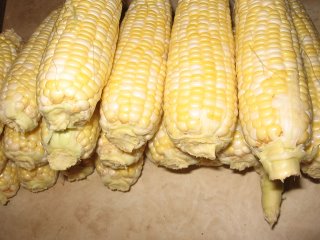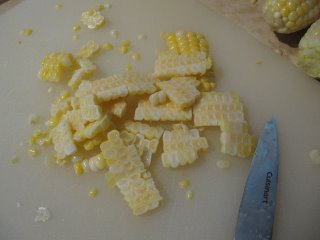 Corn
CornI don't grow corn as it takes up a lot of room but I am seriously considering growing it next year. It is very difficult to find old fashioned yellow sweet corn here. What I wouldn't give to have a few dozen ears of Libbey corn! It had nice big, deep yellow kernels that were a treat to process. Everyone seems to be growing a variety of Peaches & Cream corn so that's what I have to settle for. While peaches & cream cultivars are a nice eating from the cob corn, I don't feel it freezes as well.
The weather has been abnormally hot so the corn is a bit smaller and still hasn't come down in price. I decided to start with two dozen ears in the hopes of an upcoming price decrease. The farmer added a few extra ears to compensate for the size. I usually buy from him so he always gives me extra.
 Husked
HuskedMuch of the work for freezing corn is husking. It isn't difficult and not nearly as messy as preparing some fruits or vegetables. I don't compost all the husks as the amount would over burden the compost bin and pile.
Sometimes there is a little damage on the end of an ear, undeveloped kernels, or critters like the corn borer. These are removed along with any surrounding damage. This batch was surprisingly free of most of the previously mentioned. I found one corn borer. They are rather easy to spot as there is a perfectly round hole in the side of the ear through the husks. When the husk is removed there is the little critter to be pulled out.
 Blanched
BlanchedBlanching is necessary for any vegetable that will be stored frozen for more than four weeks with the exception of onions, peppers, and herbs. According to the Ball Blue Book "blanching cleanses the surface of dirt and organisms, brightens the colour, helps retain vitamins and reduces the action of enzymes which can destroy the fresh flavour after about four weeks". (Ball Blue Book, Vol. 1, 2000. Pp. 95). Blanching simply means to place the vegetables in boiling water for certain amount of time then cool as quickly as possible to stop the cooking process. I blanched the corn on the cob in small batches for eight minutes. Each batch was quickly cooled in the sink with cold water and ice cubes. Once the corn was cooled, it was time to cut the corn from the cob.
 Cut From Cob
Cut From CobFreezer space is always at a premium even though I have two chest freezers. I seldom freeze corn on the cob for that very reason. To cut the corn from the cob, I stand the cob on end the cut from top to bottom using a sharp paring knife. It is important that the knife is sharp! A dull knife is sure to slip in this application increasing the chances of being injured. A good knife sharpener that sharpens and hones along with a steel are worth their weight in gold in the kitchen.
 Niblets
NibletsThe niblets go into a huge stainless steal bowl. This bowl is about sixteen inches in diameter and about six inches deep. It is my favourite bowl for processing larger batches of fruits or vegetables. Once all the niblets are in the bowl, I separate them using my hands and a swishing motion. I like vacuum sealing the niblets but zip loc bags can be used as well.
 Vacuum Sealed Corn Niblets
Vacuum Sealed Corn NibletsI prefer using bags for corn verses containers. They can be stacked saving valuable freezer space. I used two types of bags to vacuum seal the corn using my Rival Seal-A-Meal. On the left, about 1 1/2 c of corn along with a pat of butter was packed into Seal-A-Meal cooking pouches (50068). I bought these pouches through Rival in 1999 and am not sure if they are still available. They are quite convenient for travelling and camping. On the right, the corn was packed into custom made bags then vacuum sealed. These bags each contain about 2 1/2 cups of corn. The bags were placed in the freezer to freeze flat.

I'm glad you are finding my blog interesting. Thanks so much for your lovely comments.
ReplyDeleteThanks for the idea of freezing corn. I love corn and would love to eat it year round. I'll have to try it.
ReplyDeletecan you can chicken corn soup?
ReplyDeleteHi Anonymous, yes you can can chicken corn soup providing it does not have rice, pasta or barley in it. Processing is at 10 lb pressure 75 minutes for 500 ml jars and 90 minutes for 1 L jars.
ReplyDelete